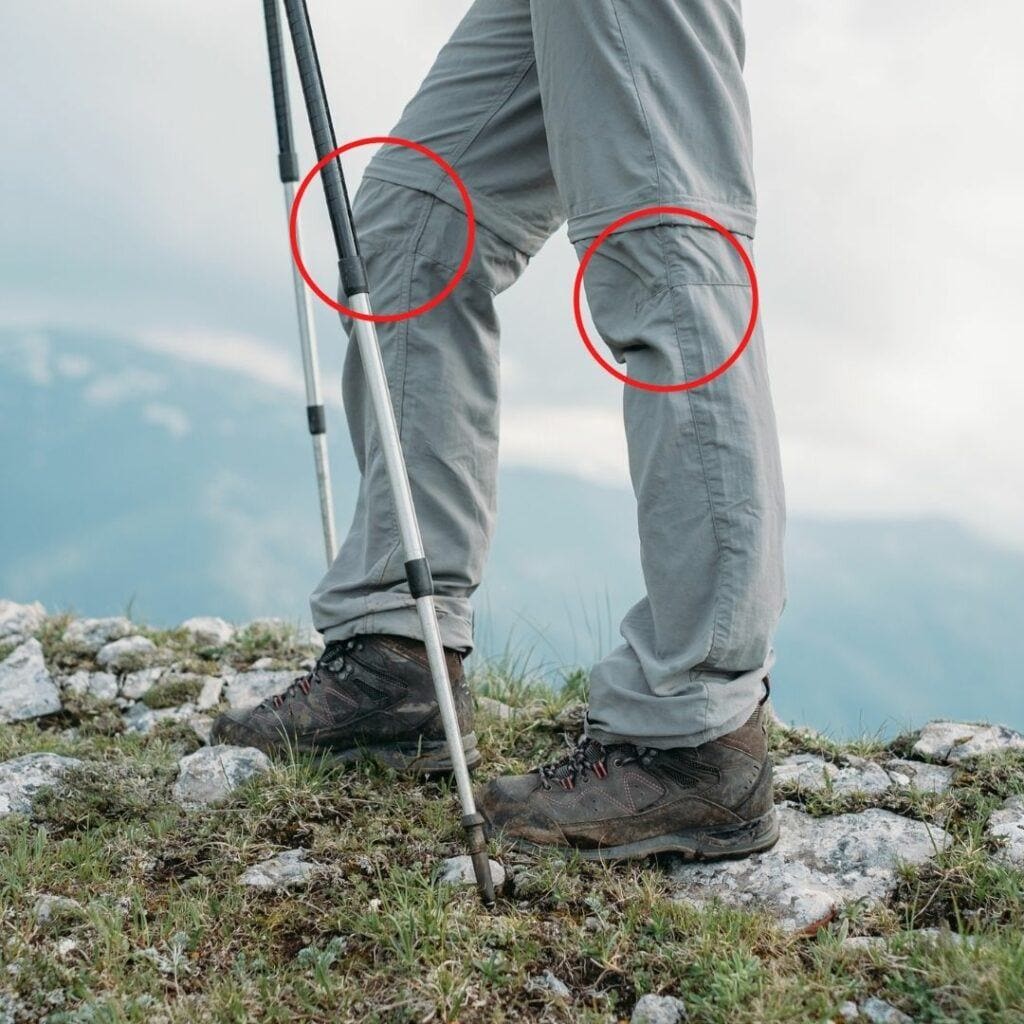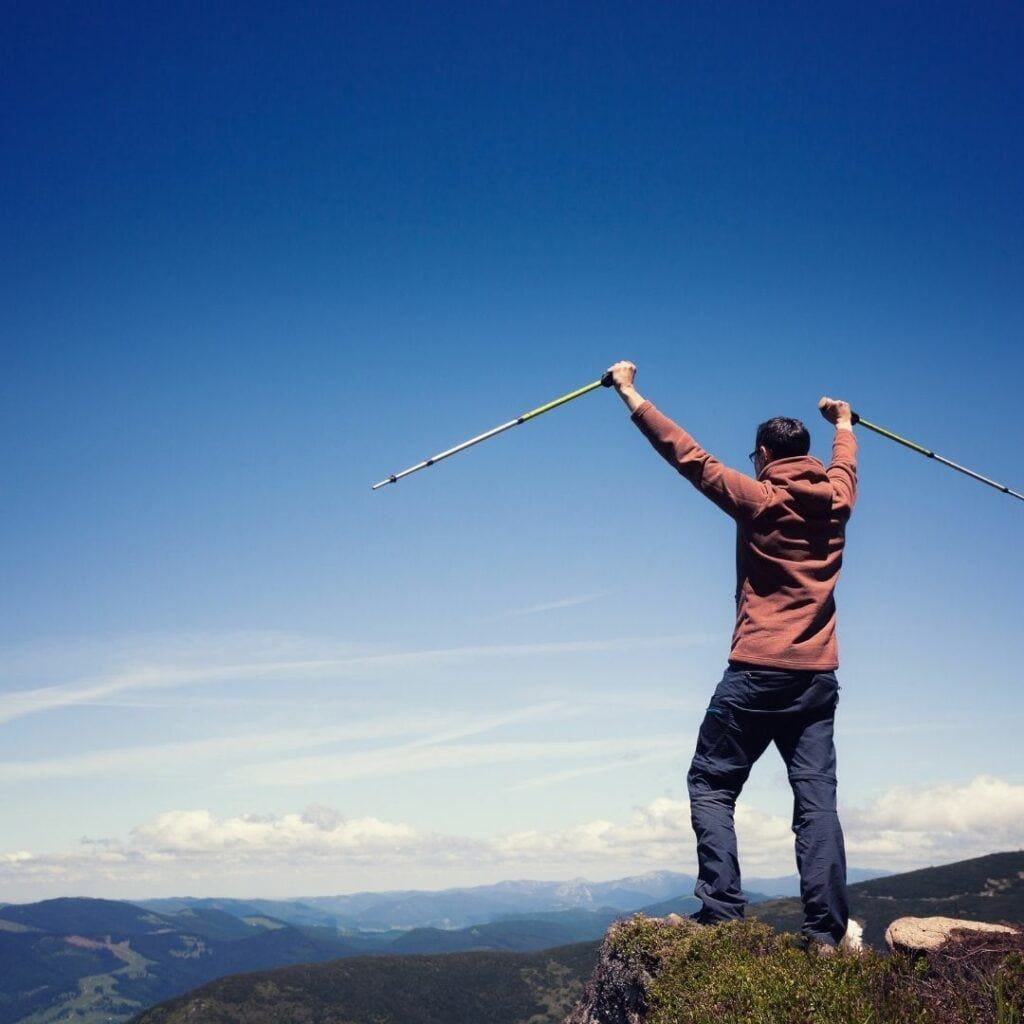5 Great Benefits of Using Hiking Poles For The Outdoors

I used to think that hiking poles (also known as trekking poles) were only beneficial for elderly or injured hikers. But then my opinion about them changed drastically. And today, I am a huge proponent of you using them and I’ll give you 5 serious reasons why.
The fact of the matter is, these tools aren’t just useful, but they can seriously extend your hiking life and prevent serious injuries and if you’re someone who has only seen them, briefly heard of them or is on the fence about getting them, I hope you take what I’m going to tell you in this article seriously and consider getting yourself a pair (I already ordered mine).

 While there’s different types of hikes you can do, for the most part, when you trail run, or walk through the woods, you are engaging different muscle groups. For trail runners, most of the muscles that are affected by trail runs are your legs, knees, thighs, back and core.
When you incorrectly hike or try to quickly run through a trail (up, down or flat), you are more likely to stomp on the ground and resort to having to do quick motions that can impact your muscle groups in a serious way.
For the most part, the very act of stomping on the ground when you run affects the knees and heels most of all and this can make walking afterwards a torturous experience (and I’m speaking from my own experiences here).
While there’s different types of hikes you can do, for the most part, when you trail run, or walk through the woods, you are engaging different muscle groups. For trail runners, most of the muscles that are affected by trail runs are your legs, knees, thighs, back and core.
When you incorrectly hike or try to quickly run through a trail (up, down or flat), you are more likely to stomp on the ground and resort to having to do quick motions that can impact your muscle groups in a serious way.
For the most part, the very act of stomping on the ground when you run affects the knees and heels most of all and this can make walking afterwards a torturous experience (and I’m speaking from my own experiences here).
 When you think about all the stomping, and hard impact on your legs done when you hike without these poles, it’s no wonder that so many people start feeling the injuries and consequences quickly.
Even if you do a serious 10 mile trail run through the woods, all that stomping might make it really tough to finish that run (including adding up injuries for future runs).
But add a hiking pole to that 10 mile run and with all the impact you’ll save off your legs (they’ll thank you for it), your longevity in how far you can go can easily double.
So instead of doing a 10 mile run and be tired, injured and sore, you can do 20 miles, be tired, but less sore and be ready for another run sooner rather than later.
Speaking from research, even the top hikers I personally follow use and suggest using trekking poles for your major and long hikes.
So if you don’t want to take the word of a newbie, take the word of experts. This is a subject they are almost all aligned on.
When you think about all the stomping, and hard impact on your legs done when you hike without these poles, it’s no wonder that so many people start feeling the injuries and consequences quickly.
Even if you do a serious 10 mile trail run through the woods, all that stomping might make it really tough to finish that run (including adding up injuries for future runs).
But add a hiking pole to that 10 mile run and with all the impact you’ll save off your legs (they’ll thank you for it), your longevity in how far you can go can easily double.
So instead of doing a 10 mile run and be tired, injured and sore, you can do 20 miles, be tired, but less sore and be ready for another run sooner rather than later.
Speaking from research, even the top hikers I personally follow use and suggest using trekking poles for your major and long hikes.
So if you don’t want to take the word of a newbie, take the word of experts. This is a subject they are almost all aligned on.
 The scenario here is simple: You love hiking, but because you don’t use hiking poles, you keep adding wear and tear on your legs.
Overtime, this can lead to long term injuries and while letting it heal would be the best policy, your love for hiking keeps you coming back and further adding harm. This is a bad deal in the long run as it lowers your hiking longevity as your injuries will sooner or later catch up to you.
But by adding hiking poles to your trips, you can take that impact off your legs and thus allow for the healing to take it’s course. This happens because:
The scenario here is simple: You love hiking, but because you don’t use hiking poles, you keep adding wear and tear on your legs.
Overtime, this can lead to long term injuries and while letting it heal would be the best policy, your love for hiking keeps you coming back and further adding harm. This is a bad deal in the long run as it lowers your hiking longevity as your injuries will sooner or later catch up to you.
But by adding hiking poles to your trips, you can take that impact off your legs and thus allow for the healing to take it’s course. This happens because:
How and why my views on hiking (trekking) poles changed:
Doing hikes in your teens, 20’s and even 30’s can be very worry free. You can run for miles, parkour off rocks and stomp on the ground as much as you like without worries. Your youth keeps you in this game and many injuries and otherwise high impact motions and bumps can be shrugged off. But despite being in my 30’s, as I recently started learning the hard way, if you keep doing doing trail runs and serious hikes on a consistent basis, overtime (even quickly), not only will you be more injury prone, but they may quickly might stack up, and cascade into long term health problems that can not just prevent you from freely hiking and enjoying the outdoors, but put you out of commission, even for the rest of your life.Here’s where my opinion of trekking poles changed forever:
In my case, while I’ve hiked for many, many miles over my lifetime, done serious trail running and plan to keep doing it for as long as I live, reality sometimes come into the picture and adjusts my views. Such was the case a few days ago after I ran some trails at High Point State Park. I didn’t hike for awhile before then, and I had been out of commission from my regular training regiments due to injuries and without thinking about stretching or warming up my muscles, I began trail running through this park without any worries. It didn’t take long for my knees, legs and cardio to tell me “slow down bud” and though I finished my runs without injury, after getting back home and stepping out of my car, reality set in quickly:- My heels were killing me.
- My thighs were not in the best shape.
- And my knees were also hurting.
What are hiking poles (trekking poles)?
They are special “walking sticks” which give your body better support when you’re hiking basically and help reduce the impact your feet and legs feel when you step on hard surfaces in the outdoors. With that one major function alone, they can promote many health benefits which I’m about to discuss:The 5 major benefits of using hiking (trekking) poles:

- They can reduce serious injuries across your body (joints).
- They can extend your hiking longevity by many years and decades.
- They can extend how far you can hike (by many miles).
- They can help people with existing injuries still be able to hike.
- They can help heal up existing injuries from people who have hiked unprepared in the past.
1) Hiking (trekking) poles can prevent serious injuries in general:
 While there’s different types of hikes you can do, for the most part, when you trail run, or walk through the woods, you are engaging different muscle groups. For trail runners, most of the muscles that are affected by trail runs are your legs, knees, thighs, back and core.
When you incorrectly hike or try to quickly run through a trail (up, down or flat), you are more likely to stomp on the ground and resort to having to do quick motions that can impact your muscle groups in a serious way.
For the most part, the very act of stomping on the ground when you run affects the knees and heels most of all and this can make walking afterwards a torturous experience (and I’m speaking from my own experiences here).
While there’s different types of hikes you can do, for the most part, when you trail run, or walk through the woods, you are engaging different muscle groups. For trail runners, most of the muscles that are affected by trail runs are your legs, knees, thighs, back and core.
When you incorrectly hike or try to quickly run through a trail (up, down or flat), you are more likely to stomp on the ground and resort to having to do quick motions that can impact your muscle groups in a serious way.
For the most part, the very act of stomping on the ground when you run affects the knees and heels most of all and this can make walking afterwards a torturous experience (and I’m speaking from my own experiences here).
Where hiking trekking poles help solve this problem:
Their basic function is to reduce the impact your legs have on the ground by taking most of the force of your motions. That way when you run, you’re still able to go at a pretty fast pace, but with the hiking poles touching the ground force, they take much of the impact off your legs and thus allow you to be less accident prone from stomping 100% full force on the ground. This can prevent serious knee and heel problems (and it does if you use the hiking poles correctly).2) Hiking poles can extend your hiking longevity by a lot:
There’s no way a person who wants to do long treks or serious trail runs can last long without hiking poles. Eventually the numbers (your age, and times you’ve heavily impacted your legs from running) will come back to haunt you and by using trekking poles, and taking that impact off your legs, you can seriously extend your hiking life by a lot. I want to be able to hike when I’m 70, 80 and even 90 and trekking poles used in my 30’s and for serious hikes can make that dream a reality. By taking the impact off my legs through using them, I can prevent immediate and long term injuries to my legs, knees and heels and thus be able to healthy enough to keep hiking for many more decades. Your hiking longevity will naturally decrease as you get older, but depending on whether or not you use hiking poles as you get older will play a pivotal role in how long you can keep hiking for and with them on your side, you will be able to do it for a lot longer.3) Trekking poles can extend how far you can hike:
 When you think about all the stomping, and hard impact on your legs done when you hike without these poles, it’s no wonder that so many people start feeling the injuries and consequences quickly.
Even if you do a serious 10 mile trail run through the woods, all that stomping might make it really tough to finish that run (including adding up injuries for future runs).
But add a hiking pole to that 10 mile run and with all the impact you’ll save off your legs (they’ll thank you for it), your longevity in how far you can go can easily double.
So instead of doing a 10 mile run and be tired, injured and sore, you can do 20 miles, be tired, but less sore and be ready for another run sooner rather than later.
Speaking from research, even the top hikers I personally follow use and suggest using trekking poles for your major and long hikes.
So if you don’t want to take the word of a newbie, take the word of experts. This is a subject they are almost all aligned on.
When you think about all the stomping, and hard impact on your legs done when you hike without these poles, it’s no wonder that so many people start feeling the injuries and consequences quickly.
Even if you do a serious 10 mile trail run through the woods, all that stomping might make it really tough to finish that run (including adding up injuries for future runs).
But add a hiking pole to that 10 mile run and with all the impact you’ll save off your legs (they’ll thank you for it), your longevity in how far you can go can easily double.
So instead of doing a 10 mile run and be tired, injured and sore, you can do 20 miles, be tired, but less sore and be ready for another run sooner rather than later.
Speaking from research, even the top hikers I personally follow use and suggest using trekking poles for your major and long hikes.
So if you don’t want to take the word of a newbie, take the word of experts. This is a subject they are almost all aligned on.
4) Hiking poles can help people with existing injuries still be able to hike:
I know a bit about injuries and one of my most major ones was knee problems I had in my teens and 20’s due to lyme disease. And from time to time, when I jog or run through the woods, I’m reminded of that (thankfully not as bad as it once was). But adding a hiking pole to my journey (and to yours), and reducing the impact on my knees, I feel like I can glide through many trail runs and protect my knees from further harm. This can help me enjoy the hobby now and in the future without adding wear and tear on my knees and other muscles in the body.5) Hiking poles can help people with existing injuries who want to hike heal up to actually do it:
 The scenario here is simple: You love hiking, but because you don’t use hiking poles, you keep adding wear and tear on your legs.
Overtime, this can lead to long term injuries and while letting it heal would be the best policy, your love for hiking keeps you coming back and further adding harm. This is a bad deal in the long run as it lowers your hiking longevity as your injuries will sooner or later catch up to you.
But by adding hiking poles to your trips, you can take that impact off your legs and thus allow for the healing to take it’s course. This happens because:
The scenario here is simple: You love hiking, but because you don’t use hiking poles, you keep adding wear and tear on your legs.
Overtime, this can lead to long term injuries and while letting it heal would be the best policy, your love for hiking keeps you coming back and further adding harm. This is a bad deal in the long run as it lowers your hiking longevity as your injuries will sooner or later catch up to you.
But by adding hiking poles to your trips, you can take that impact off your legs and thus allow for the healing to take it’s course. This happens because:
- You are not longer adding the stomping, as well as wear and tear on your legs, thus allowing your muscles to heal.
- You prevent major injuries in the future by using trekking poles and reducing the impact on your legs.
More quick and common questions about trekking poles:
Do trekking poles really make a difference?
When used correctly, absolutely! Trekking poles have made hiking much more easier for me and I am able to hike further and longer thanks to them.What is the difference between hiking and trekking poles?
The main differences between hiking and trekking poles is that trekking poles can be folded up, making them easier to carry as well as lighter so it’s more convenient.Is it good to walk with trekking poles?
If you intend to walk in nature and have joint pain, then yes it would be good to walk with trekking poles.What is the purpose of a trekking pole?
Trekking poles mainly help reduce putting all your weight on knees and joints and damaging them further. This allows you to keep hiking longer and more difficult terrains without adding more long term injuries.What height trekking pole do I need?
The good thing about most trekking poles is that they are height adjustable because you can fold them meaning no matter how tall or short you are, you can adjust them to whatever height you are comfortable with.In the end, hiking poles have many benefits, but they aren’t perfect either:
Even though I may have come across very biased toward using hiking poles, I admit that there’s numerous circumstances they aren’t useful for and may not be needed, but I cannot deny that their uses have many benefits to hikers and it’s better to have them on hand. If you know proper techniques for hiking to help reduce injury odds, then hiking poles certainly are less needed, but very few people know that type of stuff and in those situations, having these on hand makes a world of difference in not just health benefits, but for being able to enjoy the hiking and trail running hobby a bit more (and longer too).Trekking pole suggestions coming soon:
As I have just entered this new world of hiking poles, I want to hold off on any recommendations until I personally try them out and even as you read this, an order has been placed for a pair that is highly rated. You can be sure I’ll be taking these on my next major hikes. I can already think of the many places I’ve already hiked in, within which these hiking poles would come in handy:- The Catskill Mountains.
- Delaware Water Gap.
- Coyote Gulch (and other hikes in the Grand Staircase Escalante region).
- Parts of the Oregon Coast and likely Washington Coast.
- Awesome hikes that I’ve been wanting to do in Columbia River Gorge for years!

I’m a 47 year old woman with decades of experience. A month ago I was socked in by an unexpected blizzard in the mountains in Northern New Mexico. A day hike turned into a 5 day, 4 night survival situation.
No one item (or training) guaranteed my survival, but my trekking pole was absolutely invaluable. I can say with certainty that using it helped my stamina, stability and endurance, ultimately helping me hike out on my own and with little physical injury.
Wow Shannon that’s incredible! I’m glad to hear you’re OK and that the trekking poles played a huge role in you getting home safe.